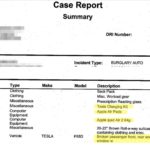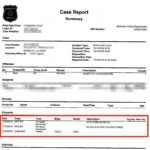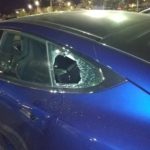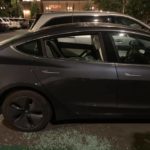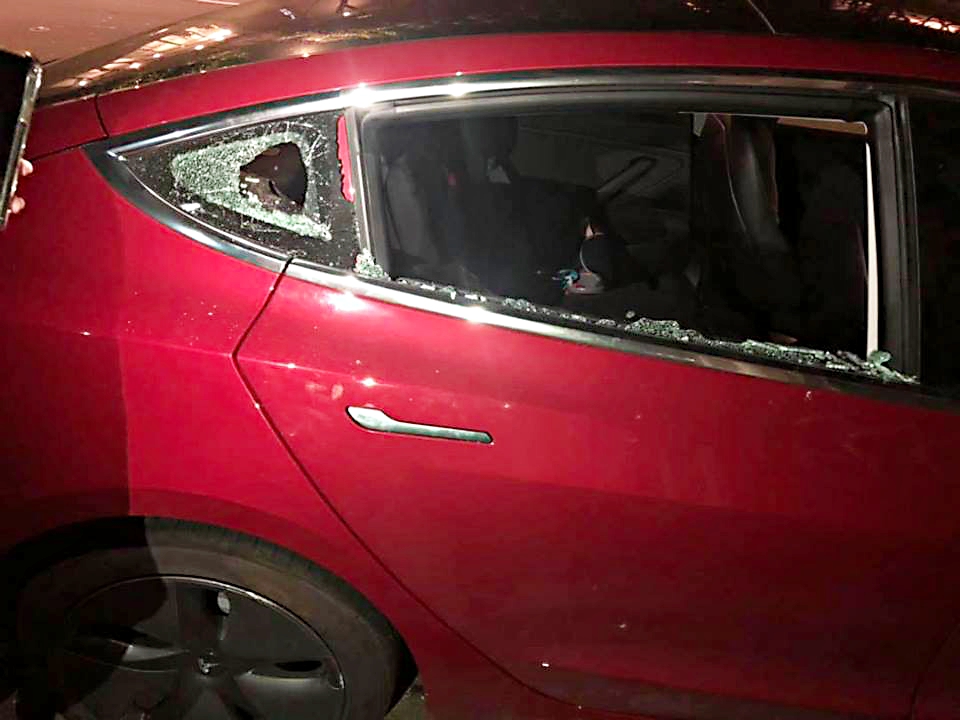
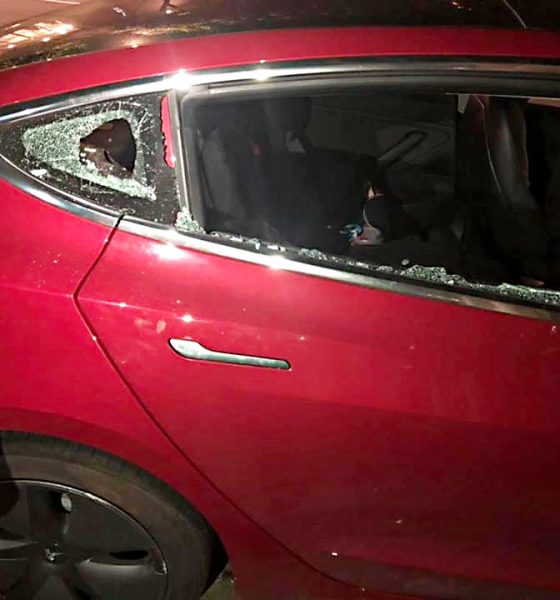
News
Tesla break-ins reward thieves with pricey valuables: Police reports
Recent break-ins, frequently reported by Tesla owners in the San Francisco Bay Area on social media sites and forums have left the community wondering if Model S, Model X, and Model 3 vehicles have become a specific target for thieves. While additional safety features are being actively addressed by Tesla via over-the-air software updates, it seems part of the theft problem is related to the assumed value of items left in the pricey vehicles.
According to police reports obtained by Teslarati from the Berkeley Police involving burglarized Tesla vehicles in recent months, thieves have successfully obtained expensive valuables left inside the all-electric cars such as luxury watches, tennis equipment, laptops, iPad Pros, and even a 1.52-carat diamond ring.
The incident reports confirmed the pattern of theft behavior already noted by owner-victims online. The preferred vehicle entry was via the rear quarter window, and after the triangular piece of glass was smashed, thieves would reach in and lower the rear seats to gain access to the trunk. Based on the reports obtained by Teslarati, there was no indication of a day or time preference for the events, several even taking place in the middle of broad daylight.
Between October 2018 and early January 2019, filings with the Berkeley Police reveal that both Model S and Model 3 vehicles were being burglarized at a rate of approximately every other week in the relatively small east bay city. Nearby Oakland and San Francisco have also become hotspots for Tesla burglaries. With the city population four to eight times greater than Berkeley, the assumed total number of Tesla break-ins taking place each week becomes staggering.
Tesla has not been tone-deaf to the security issues experienced by its customers whatsoever. In fact, several security features have been implemented over the last year. In August, “PIN to drive” requiring a PIN-entry prior to vehicle operation was released in an over-the-air software update to thwart vehicle theft. In November, an Enhanced Anti-Theft device was released via the Tesla online store to monitor movement inside locked Model S and Model X cabins. Another security enhancement came with the Version 9.0 software update, which added a built-in dash cam that enabled owners to record and save footage driving footage to an external USB drive.
Despite the continuous security enhancements being worked on by Tesla, some vehicle owners have opted to create their own solutions while waiting for something more comprehensive from the manufacturer. One tech-savvy Tesla community member and DIY enthusiast, Jon Osborne, designed a 3D-printed locking mechanism that could prevent thieves from gaining access to a Tesla vehicle’s trunk – the location frequently targeted by thieves. Another 3D printed device for sale with a similar purpose called the “Drop-Lock” was designed to install into the rear seat folding levers to prevent would-be burglars from gaining easy access to the trunk via the back seats.
Finally, of course, is the coming comprehensive security solution described in several Twitter discussions by CEO Elon Musk: the Iron Man-reminiscent Sentry Mode. Sentry Mode will likely aim to attract as much attention as possible to vehicles during a detected burglary. The security feature is expected to play Bach’s Toccata and Fugue during robbery attempts.

News
Tesla is seeing a lot of momentum from young Koreans in their 20s-30s: report
From January to November, young buyers purchased over 21,000 Teslas, putting it far ahead of fellow imported rivals like BMW and Mercedes-Benz.

Tesla has captured the hearts of South Korea’s 20s-30s demographic, emerging as the group’s top-selling imported car brand in 2025. From January to November, young buyers purchased over 21,000 Teslas, putting it far ahead of fellow imported rivals like BMW and Mercedes-Benz.
Industry experts cited by The Economist attributed this “Tesla frenzy” to fandom culture, where buyers prioritize the brand over traditional car attributes, similar to snapping up the latest iPhone.
Model Y dominates among young buyers
Data from the Korea Imported Automobile Association showed that Tesla sold 21,757 vehicles to the 20s-30s demographic through November, compared to BMW’s 13,666 and Mercedes-Benz’s 6,983. The Model Y led the list overwhelmingly, with variants like the standard and Long Range models topping purchases for both young men and women.
Young men bought around 16,000 Teslas, mostly Model Y (over 15,000 units), followed by Model 3. Young women followed a similar pattern, favoring Model Y (3,888 units) and Model 3 (1,083 units). The Cybertruck saw minimal sales in this group.
The Model Y’s appeal lies in its family-friendly SUV design, 400-500 km range, quick acceleration, and spacious cargo, which is ideal for commuting and leisure. The Model 3, on the other hand, serves as an accessible entry point with lower pricing, which is valuable considering the country’s EV subsidies.
The Tesla boom
Experts described Tesla’s popularity as “fandom culture,” where young buyers embrace the brand despite criticisms from skeptics. Professor Lee Ho-geun called Tesla a “typical early adopter brand,” comparing purchases to iPhones.
Professor Kim Pil-soo noted that young people view Tesla more as a gadget than a car, and they are likely drawn by marketing, subsidies, and perceived value. They also tend to overlook news of numerous recalls, which are mostly over-the-air software updates, and controversies tied to the company.
Tesla’s position as Korea’s top import for 2025 seems secured. As noted by the publication, Tesla’s December sales figures have not been reported yet, but market analysts have suggested that Tesla has all but secured the top spot among the country’s imported cars this year.
News
Tesla FSD fleet is nearing 7 billion total miles, including 2.5 billion city miles
As can be seen on Tesla’s official FSD webpage, vehicles equipped with the system have now navigated over 6.99 billion miles.

Tesla’s Full Self-Driving (Supervised) fleet is closing in on almost 7 billion total miles driven, as per data posted by the company on its official FSD webpage.
These figures hint at the massive scale of data fueling Tesla’s rapid FSD improvements, which have been quite notable as of late.
FSD mileage milestones
As can be seen on Tesla’s official FSD webpage, vehicles equipped with the system have now navigated over 6.99 billion miles. Tesla owner and avid FSD tester Whole Mars Catalog also shared a screenshot indicating that from the nearly 7 billion miles traveled by the FSD fleet, more than 2.5 billion miles were driven inside cities.
City miles are particularly valuable for complex urban scenarios like unprotected turns, pedestrian interactions, and traffic lights. This is also the difference-maker for FSD, as only complex solutions, such as Waymo’s self-driving taxis, operate similarly on inner-city streets. And even then, incidents such as the San Francisco blackouts have proven challenging for sensor-rich vehicles like Waymos.
Tesla’s data edge
Tesla has a number of advantages in the autonomous vehicle sector, one of which is the size of its fleet and the number of vehicles training FSD on real-world roads. Tesla’s nearly 7 billion FSD miles then allow the company to roll out updates that make its vehicles behave like they are being driven by experienced drivers, even if they are operating on their own.
So notable are Tesla’s improvements to FSD that NVIDIA Director of Robotics Jim Fan, after experiencing FSD v14, noted that the system is the first AI that passes what he described as a “Physical Turing Test.”
“Despite knowing exactly how robot learning works, I still find it magical watching the steering wheel turn by itself. First it feels surreal, next it becomes routine. Then, like the smartphone, taking it away actively hurts. This is how humanity gets rewired and glued to god-like technologies,” Fan wrote in a post on X.
News
Tesla starts showing how FSD will change lives in Europe
Local officials tested the system on narrow country roads and were impressed by FSD’s smooth, human-like driving, with some calling the service a game-changer for everyday life in areas that are far from urban centers.

Tesla has launched Europe’s first public shuttle service using Full Self-Driving (Supervised) in the rural Eifelkreis Bitburg-Prüm region of Germany, demonstrating how the technology can restore independence and mobility for people who struggle with limited transport options.
Local officials tested the system on narrow country roads and were impressed by FSD’s smooth, human-like driving, with some calling the service a game-changer for everyday life in areas that are far from urban centers.
Officials see real impact on rural residents
Arzfeld Mayor Johannes Kuhl and District Administrator Andreas Kruppert personally tested the Tesla shuttle service. This allowed them to see just how well FSD navigated winding lanes and rural roads confidently. Kruppert said, “Autonomous driving sounds like science fiction to many, but we simply see here that it works totally well in rural regions too.” Kuhl, for his part, also noted that FSD “feels like a very experienced driver.”
The pilot complements the area’s “Citizen Bus” program, which provides on-demand rides for elderly residents who can no longer drive themselves. Tesla Europe shared a video of a demonstration of the service, highlighting how FSD gives people their freedom back, even in places where public transport is not as prevalent.
What the Ministry for Economic Affairs and Transport says
Rhineland-Palatinate’s Minister Daniela Schmitt supported the project, praising the collaboration that made this “first of its kind in Europe” possible. As per the ministry, the rural rollout for the service shows FSD’s potential beyond major cities, and it delivers tangible benefits like grocery runs, doctor visits, and social connections for isolated residents.
“Reliable and flexible mobility is especially vital in rural areas. With the launch of a shuttle service using self-driving vehicles (FSD supervised) by Tesla in the Eifelkreis Bitburg-Prüm, an innovative pilot project is now getting underway that complements local community bus services. It is the first project of its kind in Europe.
“The result is a real gain for rural mobility: greater accessibility, more flexibility and tangible benefits for everyday life. A strong signal for innovation, cooperation and future-oriented mobility beyond urban centers,” the ministry wrote in a LinkedIn post.
